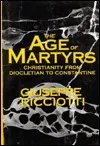Age of Martyrs
By (author): "Giuseppe Ricciotti"
Publish Date:
January 1st 1960
ISBN0880299924
ISBN139780880299923
AsinAge of Martyrs
CharactersConstantine the Great, Diocletian
Original titleThe Age of Martyrs: Christianity from Diocletian (285) to Constantine (337)
The famous Catholic historian Abbot Giuseppe Ricciotti records the epochal events of Roman history from the Rise of Diocletian (285) to the death of Constantine the Great (337), a period which witnessed the last and greatest of the 10 persecutions of the Christians by the Roman government. Included are the stories of many of the most famous martyrdoms of that period, e.g., the "The Forty Martyrs" frozen to death on the ice of a pond in Sebaste. In the rendition, the author also describes the meteoric and nearly miraclous rise of Constantine to complete control of the Empire from 307 to 324, including his lightning campaign in Italy, the famous Battle of the Milvian Bridge outside Rome (312), the epochal Edict of Milan (312), the defeat of Augustus Maximin in 313 and finally the defeat and death of the Augustus Lucinius in 324, at which time Constantine finally brought al persecution of the Christians to an end. Included, also, are the founding of Constantinople as the "Second Rome," the calling of the Council of Nicea (325) to thwart the Arian Heresy, the rise and virulence of the Donatist Heresy, the excavation of the holy places in Jerusalem, the death of Arius, and finally the baptism and death of Constantine himself in 337. Though pivotal in the history of the world, the life of Constantine the Great, as well as his thought and motives, remain in many regards shrouded in mystery. But as far as they can be known, Abbot Ricciotti has exposed them for our scrutiny. In all he has rendered a most illuminating account of the brief era in history which saw the Catholic Church emerge from persecution to freedom - to a freedom that would eventually lead to a prominence in world affairs which she has never lost and which has only been augmented with the passage of the centuries. In this sense, we still stand in the shadow of Constantine the Great.
